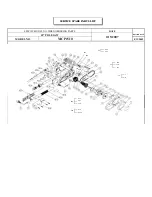
FRANÇAIS
ENGLISH
ENGLISH
FRANÇAIS
2
FRANÇAIS
ENGLISH
ENGLISH
FRANÇAIS
WARNING:
When using electric tools, machines or equipment, basic safety
precautions should always be followed to reduce the risk of fire, electric
shock, and personal injury.
READ
ALL
INSTRUCTIONS BEFORE USING THIS TOOL
1. KEEP WORK AREA CLEAN.
Cluttered areas invite injuries.
2. CONSIDER WORK AREA ENVIRONMENT.
Don’t use power tools in damp,
wet, or poorly lit locations. Don’t expose your tool to rain. Keep the work area
well lit. Don’t use tools in the presence of flammable gases or liquids.
3. KEEP CHILDREN AND BYSTANDERS AWAY.
All children should be kept
away from the work area. Don’t let them handle machines, tools or
extension cords. Visitors can be a distraction and are difficult to protect from
injury.
4. STORE IDLE EQUIPMENT.
Store
equipment in a dry area to inhibit rust.
Equipment also should be kept in a high location or locked up to keep out of
reach from children.
5. DON’T FORCE THE TOOL.
It
will do the job better and more safely at the rate
for which it was intended.
6. USE THE RIGHT TOOL.
Don’t force a small tool or attachment to do the work
of a larger industrial tool. Don’t use a tool for a purpose for which it was not
intended.
7. DRESS PROPERLY.
Don’t wear loose clothing or jewelry; they can be caught
in moving parts. Protective, non-electrically conductive gloves and non-skid
footwear are recommended when working. Wear protective hair covering to
contain long hair and keep it from harm.
8. USE EYE AND EAR PROTECTION.
Use a full-face mask if the work you’re
doing produces metal filings, dust or wood chips. Goggles are acceptable in
other situations. Wear a clean dust mask if the work involves creating a lot of
fine or coarse dust.
9. DON’T OVERREACH.
Keep proper footing and balance at all times. Do not
reach over or across machines that are running.
10. MAINTAIN TOOLS WITH CARE.
Keep tools sharp and clean for better and
safer performance. Follow instructions for lubricating and safe performance
as well as for changing accessories. Keep handles dry, clean and free from oil
and grease.
11. DISCONNECT POWER.
Unplug the tool when not in use.
12. ALWAYS CHECK AND MAKE SURE TO REMOVE ANY ADJUSTING KEYS
OR WRENCHES
before turning the tool on. Left attached, these parts can fly
off a rotating part and result in personal injury.
13. AVOID UNINTENTIONAL STARTING.
Be sure the switch is in the
OFF
position before plugging in.
14. STAY ALERT.
Watch what you are doing & use common sense.
15. CHECK FOR DAMAGED PARTS.
Before using this tool, any part that is
damaged should be carefully checked to determine that it will operate properly
and perform its intended function. Check for mis-alignment of moving parts,
binding of moving parts, breakage of parts, mountings, and other conditions
that may affect its operation. Inspect screws and tighten any ones that are
loose. Any part that is damaged should be properly repaired or replaced by
an authorized service center unless otherwise indicated elsewhere in the
instruction manual. Have defective switches replaced by an authorized service
center. Don’t use the tool if switch does not turn it on and off properly.
16. GUARD AGAINST ELECTRIC SHOCK.
Prevent body contact with grounded
surfaces: pipes, radiators, ranges, and refrigerator enclosures. When your
body is grounded the risk of electric shock increases.
17. REPLACEMENT PARTS AND ACCESSORIES.
When servicing, use only
identical replacement parts. Use of any other parts will void the warranty. Use
only accessories intended for use with this tool.
18. STAY ALERT.
Watch what you are doing & use common sense. Don’t operate
any tool when you are tired,or under the influence of alcohol or drugs.
19. WHEN WORKING OUTDOORS, USE AN OUTDOOR-RATED EXTENSION
CORD.
An extension cord rated for outdoor use must be marked “W-A” or “W”.
20. DO NOT EXPOSE ELECTRICAL POWER TOOLS TO MOISTURE.
Rain or
wet conditions can cause water to enter the tool and lead to electric shock.
IMPORTANT SAFETY INSTRUCTIONS
!



































